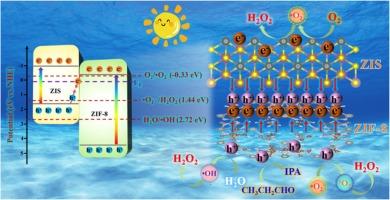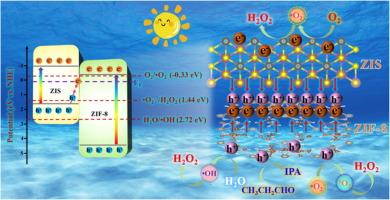新型ZIF-8/ZnIn2S4异质结在空气中可见光驱动下通过双通道反应高效生成过氧化氢
IF 13.2
1区 工程技术
Q1 ENGINEERING, CHEMICAL
引用次数: 0
摘要
从水和空气中光催化合成过氧化氢(H2O2)是传统方法的一种经济、环保的替代方法。然而,单组分光催化剂存在载体重组速度快、氧化还原能力不足等问题。此外,对于大多数光催化剂而言,水氧化反应(WOR)的不利热力学特性使双通道光催化反应的实现复杂化。在这项研究中,我们成功地通过在花状ZnIn2S4 (ZIS)上原位生长金属有机骨架ZIF-8,制备了Z-scheme异质结(ZIF-8/ZnIn2S4),用于高效产H2O2。在可见光照射下,优化后的ZIF-8/ZIS在异丙醇溶液中H2O2生成速率为742.7 μmol g−1h−1,比单独的ZIS提高了1.8倍。优异的光催化性能可归因于z型异质结促进光生电子-空穴对的有效分离和转移。飞秒瞬态吸收光谱和密度泛函理论分析证实了ZIF-8/ZIS中电荷转移的Z-scheme路径。猝灭实验、电子自旋共振分析和原位漫反射红外傅立叶变换光谱研究表明,e−和•O2−是光催化氧还原反应和WOR中产生H2O2的主要物质。该研究为合理设计和制备基于zis的异质结提供了有价值的见解,该异质结具有高效的太阳能驱动H2O2双通道合成途径。本文章由计算机程序翻译,如有差异,请以英文原文为准。


Novel ZIF-8/ZnIn2S4 heterojunction efficiently generates hydrogen peroxide via dual-channel reactions driven by visible light in air
The photocatalytic synthesis of hydrogen peroxide (H2O2) from water and air presents a cost-effective and environmental-friendly alternative to traditional methods. However, single component photocatalysts encounter challenges such as rapid carriers recombination and insufficient oxidation–reduction potential. Furthermore, the unfavorable thermodynamics associated with the water oxidation reaction (WOR) for most photocatalysts complicates the realization of dual-channel photocatalytic reactions. In this study, we successfully fabricated a Z-scheme heterojunction (ZIF-8/ZnIn2S4) by in-situ growing the metal–organic framework ZIF-8 on flower-like ZnIn2S4 (ZIS) for efficient H2O2 production. Under visible light irradiation, the optimized ZIF-8/ZIS demonstrated an impressive H2O2 generation rate of 742.7 μmol g−1h−1 in isopropanol solution, showing a 1.8-fold improvement compared to ZIS alone. The excellent photocatalytic performance can be attributed to the efficient separation and transfer of photogenerated electron-hole pairs facilitated by the Z-scheme heterojunction. Femtosecond transient absorption spectroscopy and density function theory analysis confirmed the Z-scheme route for charge transfer in ZIF-8/ZIS. Quenching experiments, electron spin resonance analysis, and in-situ diffuse reflectance infrared Fourier transform spectroscopy studies revealed that the primary reactive species, e− and •O2−, significantly contribute to H2O2 production through photocatalytic oxygen reduction reaction and WOR. This investigation provides valuable insights for the rational design and preparation of ZIS-based heterojunctions with efficient solar-driven H2O2 synthesis via a dual-channel pathway.
求助全文
通过发布文献求助,成功后即可免费获取论文全文。
去求助
来源期刊

Chemical Engineering Journal
工程技术-工程:化工
CiteScore
21.70
自引率
9.30%
发文量
6781
审稿时长
2.4 months
期刊介绍:
The Chemical Engineering Journal is an international research journal that invites contributions of original and novel fundamental research. It aims to provide an international platform for presenting original fundamental research, interpretative reviews, and discussions on new developments in chemical engineering. The journal welcomes papers that describe novel theory and its practical application, as well as those that demonstrate the transfer of techniques from other disciplines. It also welcomes reports on carefully conducted experimental work that is soundly interpreted. The main focus of the journal is on original and rigorous research results that have broad significance. The Catalysis section within the Chemical Engineering Journal focuses specifically on Experimental and Theoretical studies in the fields of heterogeneous catalysis, molecular catalysis, and biocatalysis. These studies have industrial impact on various sectors such as chemicals, energy, materials, foods, healthcare, and environmental protection.
 求助内容:
求助内容: 应助结果提醒方式:
应助结果提醒方式:


